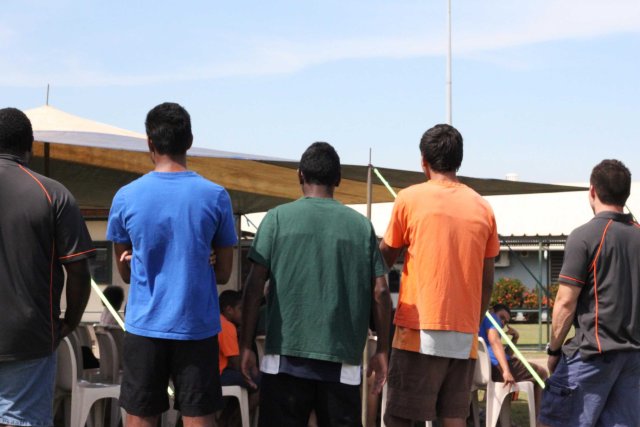
Disturbing allegations came to light on September 21 about the trouble-plagued Northern Territory juvenile justice system.
Fifteen-year-old Travis, who spent time at the Don Dale Youth Detention Centre last year, told a youth justice forum about the humiliation and depravation inside the centre. According to the ABC, Travis said staff at Don Dale made young people fight and eat animal faeces in exchange for extra junk food.
He said: “You get Coke and a chocolate once a week. So boys, they wanted a bit more than once a week, so workers would make them fight and … do stuff that kids usually wouldn’t do just so they could get it.”
One boy was allegedly dared to eat peacock faeces, and staff “videoed it and put it on SnapChat to all their friends and they gave him a coke and a chocolate”.
NT Children’s commissioner Colleen Gwynne called for an urgent investigation, but Corrections Minister Ken Middlebrook ruled it out, saying he “put no validity in it”.
But only hours after this story broke Commander Michael Murphy of NT Police Crime and Specialist Services Command said: “I can confirm Northern Territory Police are investigating a number of allegations in relation to the Don Dale Juvenile Detention Centre."
Disturbing as these allegations are, they are just the latest in string of shocking revelations about the fate of young people in custody in the NT. A report tabled in parliament on September 17 said young people at Don Dale had been kept in solitary confinement and tear gassed last year.
The report, by the NT Children’s Commissioner, was triggered by events at the centre between August 4 and 21. According to the report, six young people were being held in solitary confinement for up to 23 hours a day, in what were described as “inhumane” conditions.
The cells in the Behaviour Management Unit (BMU) have no fans or air conditioning, no access to drinking water, and a toilet but no hand washing facilities.
The young people were held in these conditions for between six and 17 days. Five of them had been involved in an escape, and were placed in the BMU when they were returned to Don Dale.
According to the report: “Correctional Services staff say they were concerned that these young people would attempt a further escape and the only secure area was the BMU.”
On August 21, theys were due to have their behaviour reviewed. When that review was delayed, they became frustrated, covering the cameras in their cells with toilet paper and making “makeshift weapons” out of plastic cutlery and plates. In response, they were told they would spend an extra 24 hours in solitary confinement.
Exactly what happened next is the subject of debate. The ABC reported Middlebrook as saying: "I was there on that night. I was the one who authorised the use of [tear] gas because I had an obligation to bring that to an end and bring it to an end quickly.”
At the time, media in the NT widely reported the gassing as the result of a riot. A witness to the event told the Children’s Commissioner: "The detainees went off and I don't blame them. I would have too. It wouldn't have happened if they didn't keep them in [the BMU] so long. It is horrible, it stinks ... I am surprised it didn't happen sooner."
Despite the stories about a “riot”, the report found that all the young people were in their cells at the time, apart from one who had escaped because staff left his door unlocked.
He became agitated, smashing some glass and opening the hatches in other cell doors to pass things through to other inmates. At this point management ordered the use of tear gas to subdue the young person who had escaped.
The tear gas affected all six young people, including those still locked in their cells. In the video, they can be heard vomiting and coughing as they tried to take cover under sheets and mattresses. There were delays in getting them out of their cells because the prison officers either didn’t have keys or did not know which keys to use.
Not long after this incident, the detention centre was relocated to a decommissioned adult prison. The new centre has already been in the spotlight this year, after a spate of breakouts and other disturbances.
Jared Sharp, from the Northern Australian Aboriginal Justice Agency said the details in the report showed why young people “would feel such desperation that they would climb over razor wire to escape, as they have … It's also why kids might leave detention when they get out damaged, feeling in the depth of despair and harmed by the experience of detention.”
In October last year, the NT government commissioned an inquiry into the youth detention system. That report, released in February, found that casual and temporary staff made up 90% of the workforce in detention centres in Alice Springs and Darwin. It said lack of training and supervision, lack of experienced staff, poor communication and direction contributed to behavioural and other problems being poorly managed.
Middlebrook defends the actions taken by staff, and ordered by him. He also denies that the cells in the BMU constitute solitary confinement.
But Ruth Barson from the Human Rights Law Centre said: "I think the Correction Commissioner's definition of solitary confinement might be a bit out of sync with the one employed by the United Nations.
The United Nations Special Rapporteur on torture has said that any use of solitary confinement, that means a young person staying alone in a cell for in excess of 23 hours, is a form of cruel, inhumane and degrading treatment."
Like the article? Subscribe to Green Left now! You can also like us on Facebook and follow us on Twitter.